How can your tomato seedlings get sick, and how it can end
Tomato seedlings do not get sick as often as adult plants in the greenhouse and garden. But any infection with bacteria and fungi at an early stage of development of seedlings leads to their death. Viral lesions are no less dangerous - they are characterized by a latent course and appear only after the seedlings are planted in a permanent place.
Disease control is difficult due to the inability to use chemicals indoors. The situation is aggravated by the fact that many folk remedies are ineffective. Experienced gardeners are advised to focus on preventive treatments.
In this article we will give a description of diseases of tomato seedlings of an infectious and non-infectious nature, talk about methods of control and prevention.
The content of the article
The main diseases of tomato seedlings
All diseases of tomato seedlings are classified into:
- fungal;
- viral;
- bacterial;
- non-infectious nature.
Modern varieties and hybrids have genetic immunity to viral diseases of the nightshade. Infection with viruses and fungi occurs with improper care, ignoring the rules for disinfecting soil and seeds, and a deficiency of minerals.
Fungal diseases
Tomato seedlings most often die as a result of infection with pathogenic fungi. The main cause of infection is poor quality soil.
Black leg or root rot is a fungal disease, the pathogens of which live in the upper layer of the earth. Under favorable conditions, the fungus quickly spreads to plant tissues: without treatment, the seedlings completely die in just a couple of days. The most vulnerable to the disease are seedlings after picking.
Blackleg
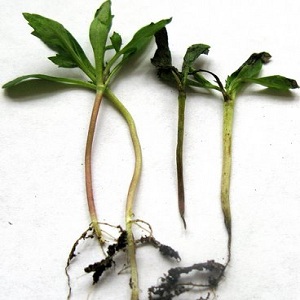
Signs of illness:
- darkening of the root collar;
- drying out of the affected part;
- constriction in the lower part of the stem;
- decay of roots.
If you pull on the stem, the plant easily comes out of the soil. In this case, the root system completely decays.
The reasons:
- contaminated soil;
- non-compliance with the rules of soil disinfection;
- excessive watering;
- dense sowing;
- lack of fresh air;
- temperature jumps.
The fight against the disease is complicated by the inability to use chemicals indoors, and there are no effective folk remedies.
At the first sign, the seedlings are removed by the root, and the remaining seedlings are irrigated with a solution of potassium permanganate and watering is stopped for a week.
If after seven days no signs of infection are detected, the seedlings are watered with solutions of biological products:
- Fitosporin (10 g per 5 l, 100 ml per sprout);
- "Trichodermin" (100 ml per 10 liters of water);
- "Maxim" (2 ml per 1 liter of water);
- "Previkur" (10 ml for 7 liters of water).
Fusarium
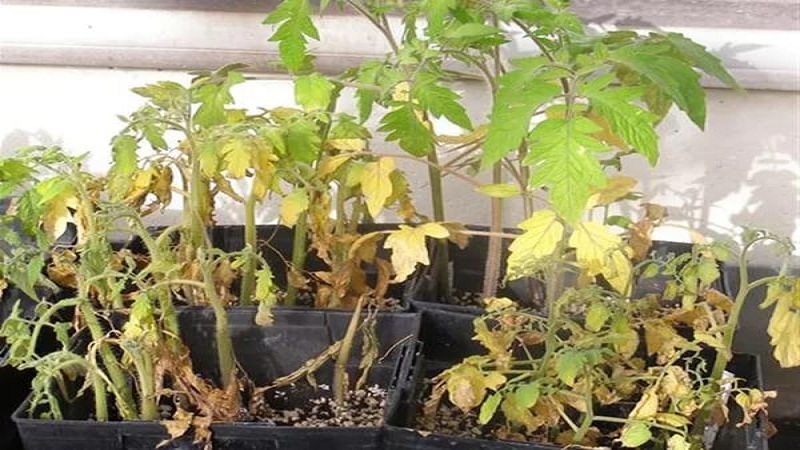
Fusarium wilting - a disease caused by fungi of the genus Fusarium. The pathogen enters the plant tissue through damaged roots when picking.
Signs:
- pink bloom on the stem and root collar;
- wilting of the lower leaves;
- yellow streaks on the leaves.
The process develops rapidly, the greens do not have time to turn yellow, the stems fall, but they hold firmly to the root.
The reasons:
- sowing seeds into the soil without preliminary disinfection;
- increased soil moisture;
- high substrate temperature (+ 24 ... + 30 ° С heat);
- excess nitrogen in the soil.
For treatment, use "Trichodermin" (100 ml per 10 liters of water) and a strong solution of potassium permanganate.
Late blight
Solanaceae disease caused by the fungus Phytophthora. The pathogen spreads with lightning speed in conditions of high humidity and completely destroys plant tissues.
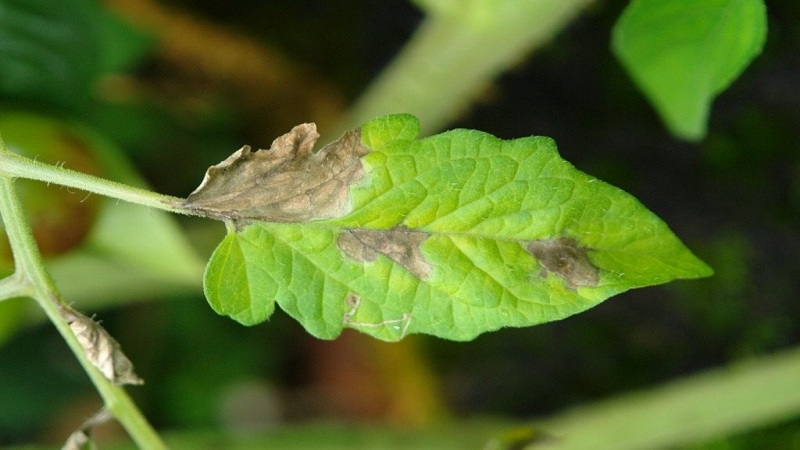
Signs:
- brown spots on the tips of the leaves;
- brown spots with a whitish coating on the back;
- brown strokes on the petioles.
At the initial stage of development, tomato seedlings tolerate the disease more easily and usually do not die. Insidiousness phytophthora lies in the amazing vitality. Even if the signs of the disease completely disappear, the seedlings remain carriers of the pathogen, and after transplanting into the ground, the pathogenic process unfolds with renewed vigor.
The reasons:
- contaminated soil and seeds;
- excessive watering of seedlings;
- excess nitrogen in the soil;
- lack of fresh air.
When the first signs are detected, it is better to remove the seedlings by the root and discard. If the seedlings need to be saved at any cost, they are treated with copper-containing preparations:
- "HOM" (20 g per 5 liters of water);
- "Abiga-Peak" (25 g per 5 liters of water).
Reference. Bordeaux mixture in the fight against late blight of tomato seedlings is ineffective.
Septoria or white leaf spot
Diseasecaused by the fungus Sephtoria lycopersici. The seedlings are infected through the soil.
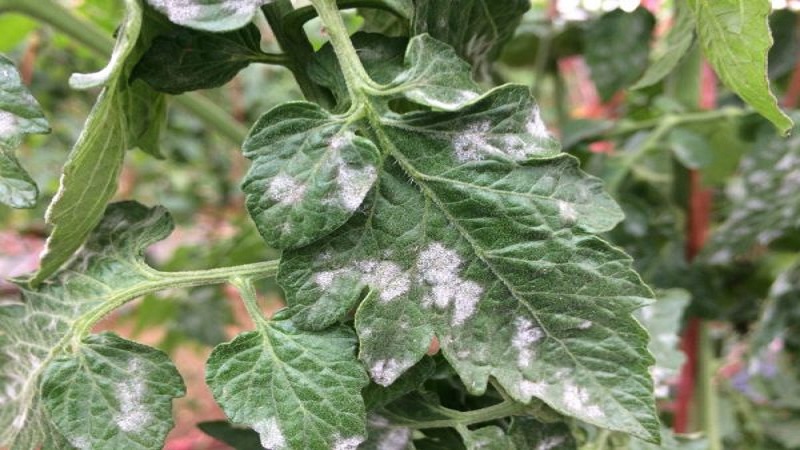
Signs:
- whitish spots with black dots (spores) on the lower leaves;
- darkening and bending of the leaves;
- oval spots on the stems.
Without treatment, the stems dry out completely, the leaves fall off.
The reasons:
- excessive moisture in the soil and air;
- infected substrate;
- increased room temperature.
If the disease is detected at an early stage of seedling development, it is better to pull out the sprouts and destroy them, they cannot be saved. Fortified seedlings are sprayed with Bordeaux liquid.
To prepare a 0.75% solution, you will need:
- 10 liters of water;
- 75 g of copper sulfate;
- 100 g of quicklime.
The treatment is carried out twice with an interval of 10 days.
Viral diseases
Symptoms of viral diseases at the stage of growing tomato seedlings are smoothed. Often the signs are completely absent, and the disease is fully manifested after transfer to the ground.
Tomato mosaic
A dangerous viral disease, the causative agent of which is hidden in the seeds... It is useless to fight the disease, you have to completely get rid of the seedlings. Light spots are formed on the leaves, arranged in the form of a mosaic. Then they turn completely yellow, wrinkle and crumble.
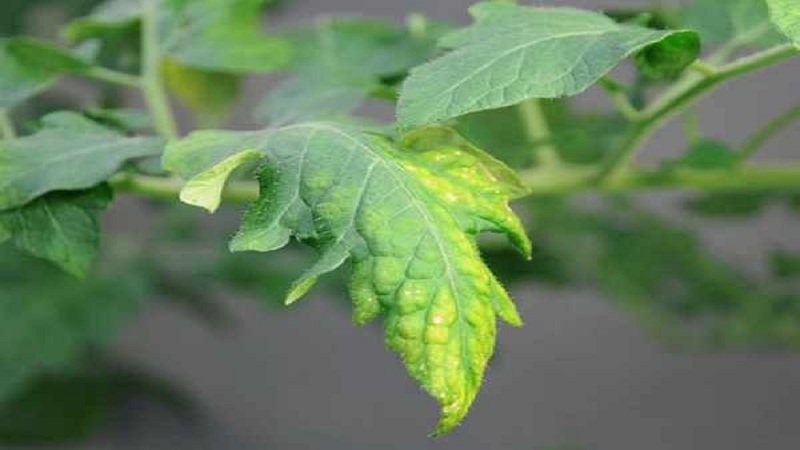
To prevent infection:
- inoculum is pickled in a strong solution of potassium permanganate;
- seedlings are watered with 1% potassium permanganate solution - twice a month;
- spraying with a solution of urea in milk (for 1 liter of milk - 1 tsp. urea), once every 10 days.
Aspermia or seedlessness
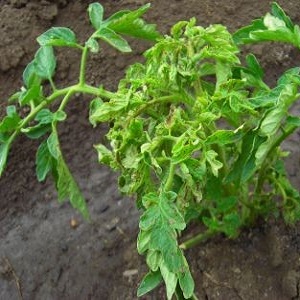
A disease caused by the Cucumovirus virus. The virus is transmitted through infected plants in conditions of high temperature and humidity. The main vector in open and closed ground is aphid.
The disease does not manifest itself at the seedling stage, the first signs can be seen after planting in the ground. The characteristic symptoms of infection are excessive bushiness of the top, underdeveloped stepsons. The upper leaves lighten and become deformed. Seeds are partially or completely absent in fruits.
To prevent the spread of the pathogen, small, painful seedlings are discarded during a dive, and strong ones are left. At the first symptoms of the disease after transfer to the ground, the seedlings are treated with the fungicides "Aktara", "Commander" to destroy aphids.
Streak
A common tomato disease caused by the tobacco mosaic virus. The reason is the growing of seedlings from the seeds of an infected fruit.
Signs:
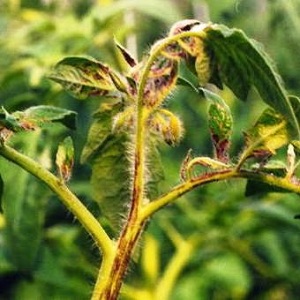
- stripes and strokes of brown-red color;
- fragility of the stems;
- dark brown spots on the leaves;
- new leaves grow curly and small.
The disease is unknowingly easy to confuse with late blight. One disease differs from another in the nature of the spots: streak gives dry, brown-brown color, and late blight - weeping, gray-brown.
For treatment, use a solution of potassium chloride (40 g per 10 liters of water). But the most reliable way is to remove the seedlings from the root and burn them.
Bacterial diseases
This is the most common group of tomato seedling disease. Treatment is complicated by the lack of effective antibacterial drugs, so the main fight is aimed at preventing infection.
Black bacterial spot
A disease caused by the gram-negative bacillus Xanthomonas vesicatoria. Favorable environment for the development of the disease - the air temperature is more than +25 ° C. Bacteria die at +54 ° C.
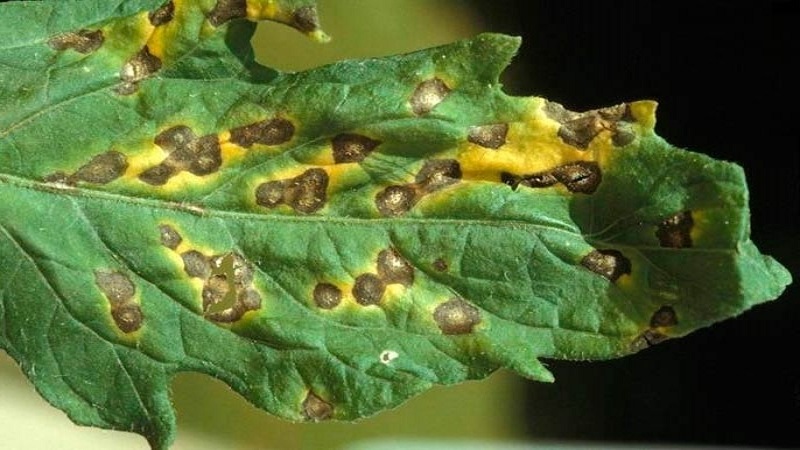
Signs:
- oily, olive spots on leaves with a diameter of 1-2 mm;
- black small spots (without white border) in the form of a rash on stems, leaves, petioles;
- dying off of leaves.
The reasons:
- increased air temperature;
- air humidity above 75%;
- moisture on the leaves when watering.
For the treatment of the disease, drugs are used:
- Fitosporin M (10 g per 5 l, 100 ml per sprout);
- Fitolavin (2 ml / 1 l of water);
- "Gamair" (2 tablets / 1 liter of water);
- "HOM" (20 g per 5 liters of water).
The solutions are used for spraying the leaves once every two weeks.
Bacterial mottling
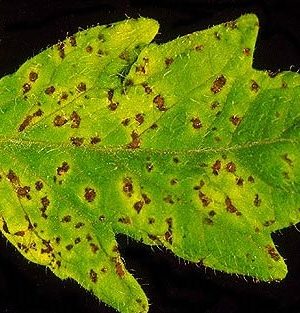
Pseudomonas syringae disease... Pathology is not particularly harmful to seedlings when controlling the process.
Signs - small brown spots with a yellow border on the lower leaves, yellowing and curling of the leaves.
The reasons are low temperature and high air humidity.
The damaged leaves are removed, and the seedlings are treated with HOM.
Non-communicable diseases
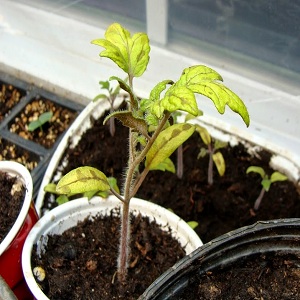
A group of diseases of a non-infectious nature is associated with a deficiency of mineral components: calcium, copper, phosphorus, potassium, nitrogen.
Diseases can be recognized by the shape of the leaves and color. Top dressing of seedlings throughout the growing season will help to solve the problem.
Signs of mineral deficiency:
- yellowing of the upper leaves indicates a lack of calcium;
- yellow and dry lower leaves - lack of copper and potassium;
- the upper leaves curl - lack of potassium;
- yellowing of leaves and red veins on the back side - nitrogen deficiency;
- light yellow color of the whole seedling - lack of magnesium;
- yellowed and twisted leaves - lack of iron;
- pale leaves with a blue tint - copper deficiency;
- blue or purple shade of leaves - phosphorus deficiency.
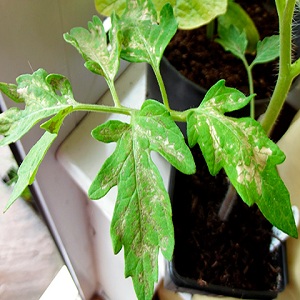
Similar symptoms occur with insufficient watering and a lack of sunlight.
And vice versa: as a result of sunburn, tomato leaves turn white, while the stems remain green.
For feeding tomato seedlings at home use: "Calbit C", "Brexil Ca", "Vuksal Calcium", "Biohumus", bird droppings, mullein, superphosphate, potassium sulfate, copper sulfate, magnesium nitrate, yeast, ash.
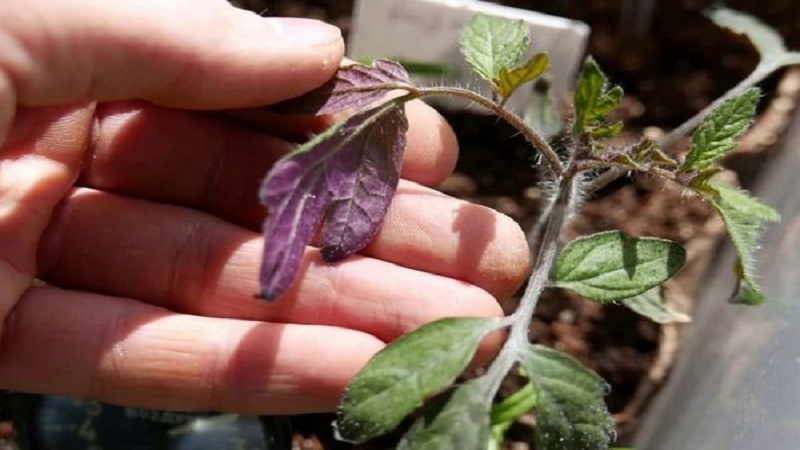
Prevention of seedling diseases
General rules for the prevention of viral, fungal and bacterial diseases:
- disinfection of soil and containers before sowing seeds;
- soaking of manually collected seed in potassium permanganate or "Fitosporin";
- preventive treatments once a week with biological preparations "Baktofit", "Trichodermin";
- moderate watering;
- maintaining an optimal level of humidity and temperature;
- airing seedlings;
- removal of infected seedlings with roots;
- thinning of seedlings;
- treatment of roots with biological products during picking and transfer to the ground.
Prevention of non-communicable diseases consists in the timely introduction of organic and mineral substances, compliance with the rules for caring for young seedlings.
Conclusion
Tomato seedlings are susceptible to various diseases. Pathologies are caused by: ignoring recommendations for disinfecting soil and seeds, excessive watering, too high or low air temperature in the room.Fungal and bacterial diseases are detected immediately after picking seedlings, viral ones are asymptomatic.
It is forbidden to use chemicals to treat diseases at home. Methods for treating seedlings are to treat seedlings with biological products and prevent infection. It is during the period of "tender" age that the disease is easier to prevent than to deal with the consequences.
Non-communicable diseases are associated with mineral deficiencies and appear as twisted, dry, yellow, purple leaves. Ready-made liquid fertilizers with nitrogen, potassium, phosphorus, calcium and magnesium help to normalize the balance of nutrients.